

Compact Muon Solenoid
LHC, CERN
| CMS-PAS-HIG-16-018 | ||
| Search for Higgs bosons produced in association with b quarks and decaying into a b-quark pair with 13 TeV data | ||
| CMS Collaboration | ||
| January 2018 | ||
| Abstract: A search for Higgs bosons that decay into a b quark-antiquark pair and are accompanied by at least one additional b quark is performed with the CMS detector. The data analyzed were recorded in proton-proton collisions at a centre-of-mass energy of 13 TeV at the LHC, corresponding to an integrated luminosity of 35.7 fb$^{-1}$. The final state considered is particularly sensitive to signatures of a Higgs sector beyond the standard model, as predicted by the minimal supersymmetric standard model (MSSM) and the two Higgs doublet model (2HDM) with large values of the parameter $\tan \beta$. No signal above the standard model background expectation is observed. Stringent upper limits on the cross section times branching fraction are set for Higgs bosons with masses up to 1300 GeV at 95% confidence level. The results are interpreted within several MSSM and 2HDM scenarios. In the hMSSM scenario, upper limits on $\tan \beta$ are obtained, ranging from 22 to 60 for Higgs masses from 300 to 900 GeV. In the flipped 2HDM scenario, similar upper limits on $\tan \beta$ are set over the full $\cos(\beta-\alpha)$ range and for Higgs masses from 300 to 850 GeV. | ||
|
Links:
CDS record (PDF) ;
inSPIRE record ;
CADI line (restricted) ;
These preliminary results are superseded in this paper, JHEP 08 (2018) 113. The superseded preliminary plots can be found here. |
||
| Figures | |

png pdf |
Figure 1:
Example Feynman diagrams of the signal processes. |

png pdf |
Figure 1-a:
Example Feynman diagram of the signal process. |
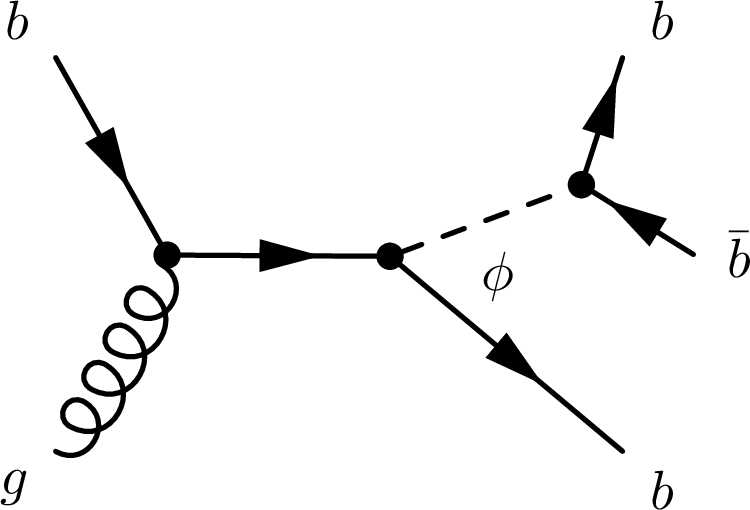
png pdf |
Figure 1-b:
Example Feynman diagram of the signal process. |
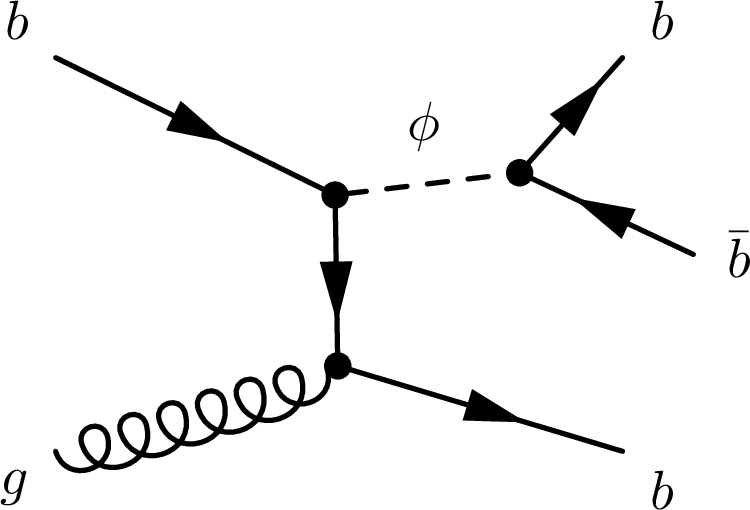
png pdf |
Figure 1-c:
Example Feynman diagram of the signal process. |
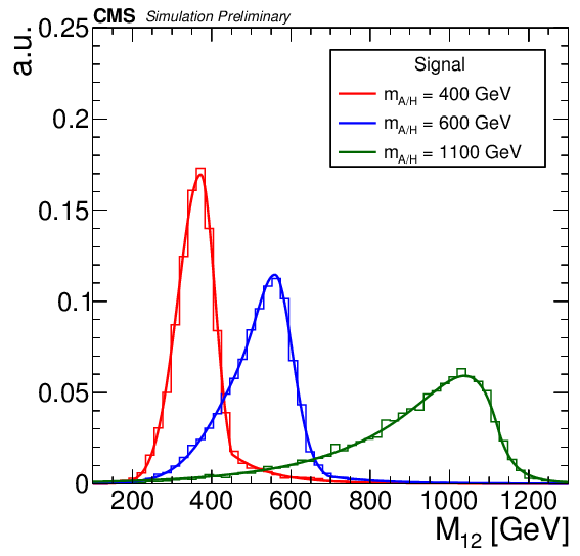
png pdf |
Figure 2:
Signal mass distributions and parameterizations as obtained from simulation for different Higgs masses: 400 GeV (red), 600 GeV (blue), and 1100 GeV (green). |

png pdf |
Figure 3:
Signal efficiency as a function of the Higgs boson mass after different stages of event selection: offline kinematic selection (black), online trigger selection (red) and offline b tagging selection (green). |
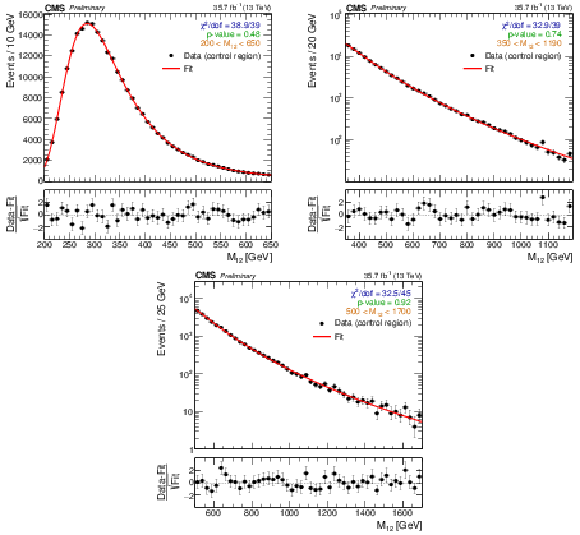
png pdf |
Figure 4:
Invariant dijet mass $ {\mathrm {M}_{12}} $ in the reverse-b-tag control region in the three subranges used for the fit: $ {\mathrm {M}_{12}} = $ [200, 650] GeV (top left) in linear scale, $ {\mathrm {M}_{12}} = $ [350, 1190] GeV (top right) and $ {\mathrm {M}_{12}} = $ [500, 1700] GeV (bottom) in logarithmic scale. The dots represent the data. The red line is the result of the fit of the background parameterizations described in the text. In the bottom panel of each plot the normalized difference ($\frac {\mathrm {Data}-\mathrm {Fit}}{\sqrt {\mathrm {Fit}}}$) is shown. |
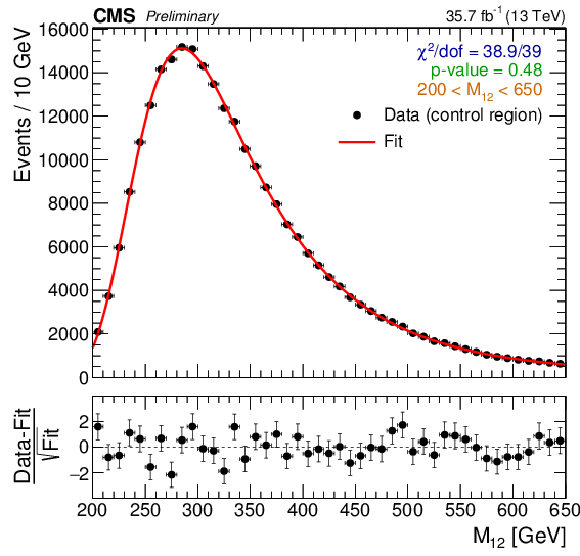
png pdf |
Figure 4-a:
Invariant dijet mass $ {\mathrm {M}_{12}} $ in the reverse-b-tag control region in the one of the subranges used for the fit: $ {\mathrm {M}_{12}} = $ [200, 650] GeV in linear scale. The dots represent the data. The red line is the result of the fit of the background parameterizations described in the text. In the bottom panel the normalized difference ($\frac {\mathrm {Data}-\mathrm {Fit}}{\sqrt {\mathrm {Fit}}}$) is shown. |

png pdf |
Figure 4-b:
Invariant dijet mass $ {\mathrm {M}_{12}} $ in the reverse-b-tag control region in the one of the subranges used for the fit: $ {\mathrm {M}_{12}} = $ [350, 1190] GeV in logarithmic scale. The dots represent the data. The red line is the result of the fit of the background parameterizations described in the text. In the bottom panel the normalized difference ($\frac {\mathrm {Data}-\mathrm {Fit}}{\sqrt {\mathrm {Fit}}}$) is shown. |
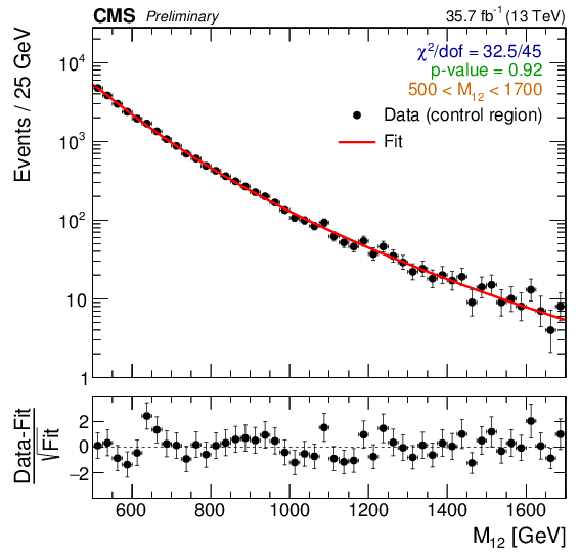
png pdf |
Figure 4-c:
Invariant dijet mass $ {\mathrm {M}_{12}} $ in the reverse-b-tag control region in the one of the subranges used for the fit: $ {\mathrm {M}_{12}} = $ [500, 1700] GeV in logarithmic scale. The dots represent the data. The red line is the result of the fit of the background parameterizations described in the text. In the bottom panel the normalized difference ($\frac {\mathrm {Data}-\mathrm {Fit}}{\sqrt {\mathrm {Fit}}}$) is shown. |
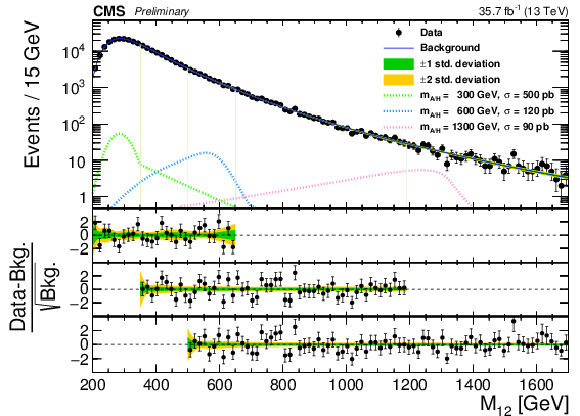
png pdf |
Figure 5:
Distribution of the dijet mass $ {\mathrm {M}_{12}} $ in the data triple-b-tag sample showing the three subranges together with the background-only fit. The shaded area shows the post-fit uncertainty. For illustration, the expected signal contribution for three representative mass points is shown, scaled to cross sections suitable for visualization. The kink at around 350 GeV of the 300 GeV signal shape is caused by the wrong-pairing background. In the bottom panels the normalized difference ($\frac {\mathrm {Data}-\mathrm {Bkg}}{\sqrt {\mathrm {Bkg}}}$), where Bkg is the background as estimated by the fit, for the three subranges is shown. |
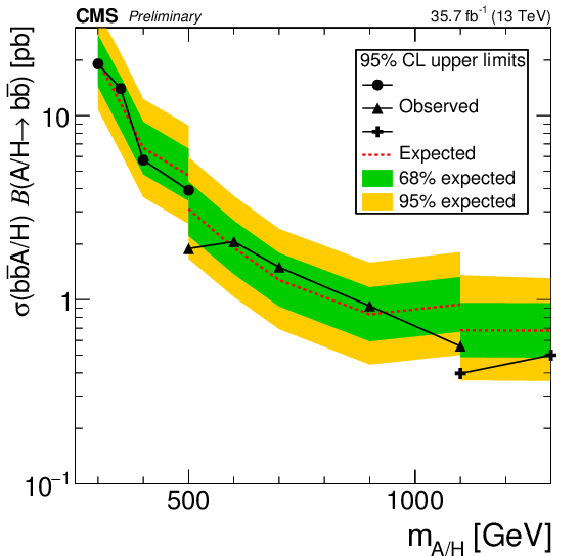
png pdf |
Figure 6:
Expected and observed upper limits on $\sigma ({\mathrm {p}} {\mathrm {p}}\to {\mathrm {b}} {\rm A/H}+\mathrm {X})\, \mathcal {B}({\rm A/H}\to {{\mathrm {b}} {\overline {\mathrm {b}}}})$ at 95% CL as a function of the Higgs boson mass ${m_{\mathrm {A/H}}}$. For the observed limit, three different marker types are used to distinguish the three subranges in which the results have been obtained. The inner (green) band and the outer (yellow) band indicate the regions containing 68 and 95%, respectively, of the distribution of limits expected under the background-only hypothesis. |
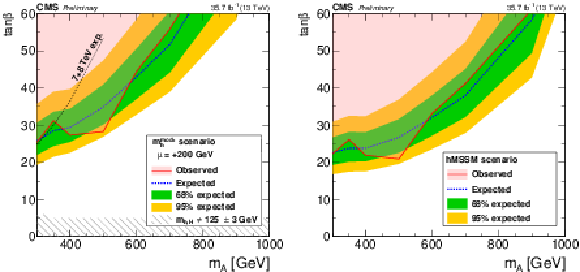
png pdf |
Figure 7:
Expected and observed upper limits at 95% CL for ${m_{\mathrm {A/H}}}$ vs. the MSSM parameter $ \tan \beta $ in the (left) $m_{\rm h}^{\rm mod+}$ benchmark scenario with $\mu = $ +200 GeV, and (right) in the hMSSM scenario. The inner (green) band and the outer (yellow) band indicate the regions containing 68 and 95%, respectively, of the distribution of limits expected under the background-only hypothesis. The excluded parameter space is indicated by the red shaded area. |
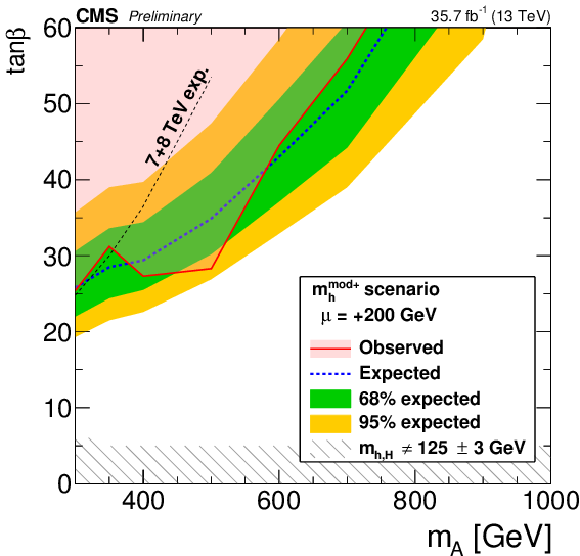
png pdf |
Figure 7-a:
Expected and observed upper limits at 95% CL for ${m_{\mathrm {A/H}}}$ vs. the MSSM parameter $ \tan \beta $ in the $m_{\rm h}^{\rm mod+}$ benchmark scenario with \mu = $ +200 GeV. The inner (green) band and the outer (yellow) band indicate the regions containing 68 and 95%, respectively, of the distribution of limits expected under the background-only hypothesis. The excluded parameter space is indicated by the red shaded area. |
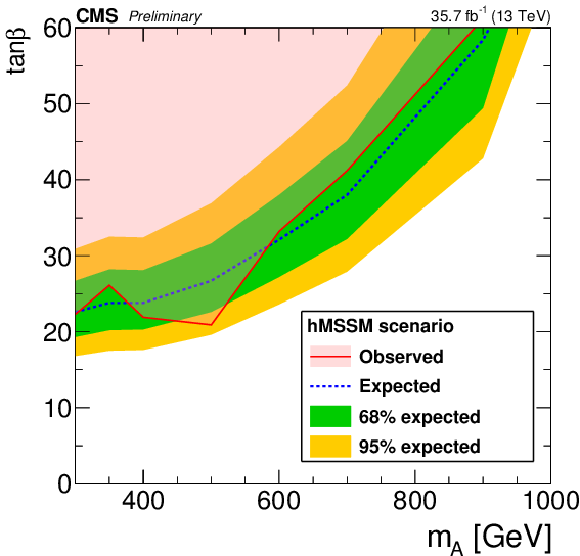
png pdf |
Figure 7-b:
Expected and observed upper limits at 95% CL for ${m_{\mathrm {A/H}}}$ vs. the MSSM parameter $ \tan \beta $ in the hMSSM scenario. The inner (green) band and the outer (yellow) band indicate the regions containing 68 and 95%, respectively, of the distribution of limits expected under the background-only hypothesis. The excluded parameter space is indicated by the red shaded area. |

png pdf |
Figure 8:
Expected and observed upper limits at 95% CL for ${m_{\mathrm {A/H}}}$ vs. the MSSM parameter $ \tan \beta $ in the (left) light $ \tilde{\tau} $ and the (right) light $ \tilde{\mathrm {t}} $ benchmark scenarios. The inner (green) band and the outer (yellow) band indicate the regions containing 68 and 95%, respectively, of the distribution of limits expected under the background-only hypothesis. The excluded parameter space is indicated by the red shaded area. |
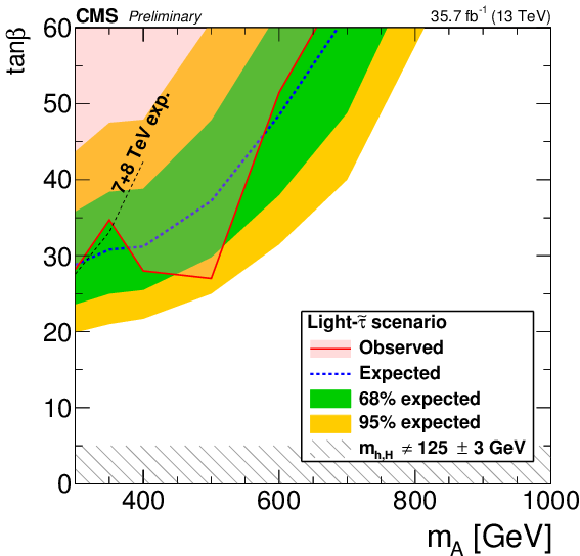
png pdf |
Figure 8-a:
Expected and observed upper limits at 95% CL for ${m_{\mathrm {A/H}}}$ vs. the MSSM parameter $ \tan \beta $ in the light $ \tilde{\tau} $ benchmark scenarios. The inner (green) band and the outer (yellow) band indicate the regions containing 68 and 95%, respectively, of the distribution of limits expected under the background-only hypothesis. The excluded parameter space is indicated by the red shaded area. |
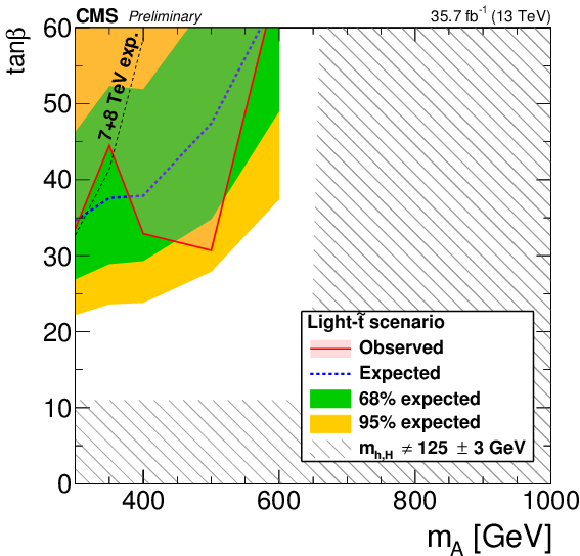
png pdf |
Figure 8-b:
Expected and observed upper limits at 95% CL for ${m_{\mathrm {A/H}}}$ vs. the MSSM parameter $ \tan \beta $ in the light $ \tilde{\mathrm {t}} $ benchmark scenarios. The inner (green) band and the outer (yellow) band indicate the regions containing 68 and 95%, respectively, of the distribution of limits expected under the background-only hypothesis. The excluded parameter space is indicated by the red shaded area. |
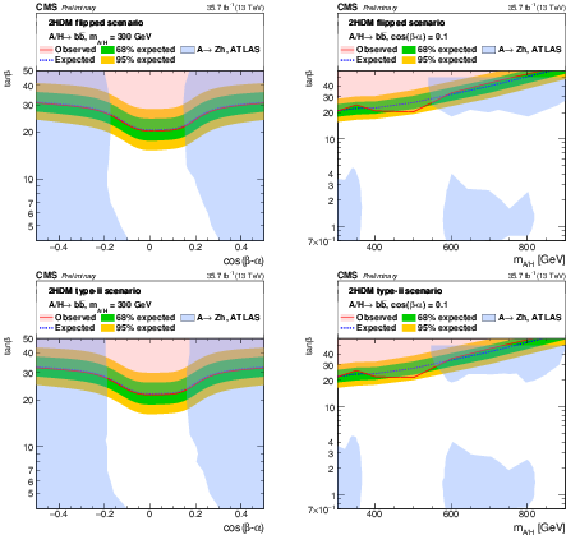
png pdf |
Figure 9:
Upper limits for the parameter $ \tan \beta $ at 95% confidence level for the flipped (upper) and type-II (lower) models, as a function of $\cos (\beta -\alpha)$ in the range of $[-0.5,0.5]$ for the mass $m_{\rm H}=m_{\rm A}= $ 300 GeV (left) and as a function of ${m_{\mathrm {A/H}}}$ when $\cos (\beta -\alpha) = $ 0.1 (right). The results from the ATLAS $\mathrm {A} \rightarrow {\mathrm {Z}} {\mathrm {h}} $ analysis [32] are also shown as blue shaded area for comparison which provide limits up to $ \tan \beta $ of 50. |
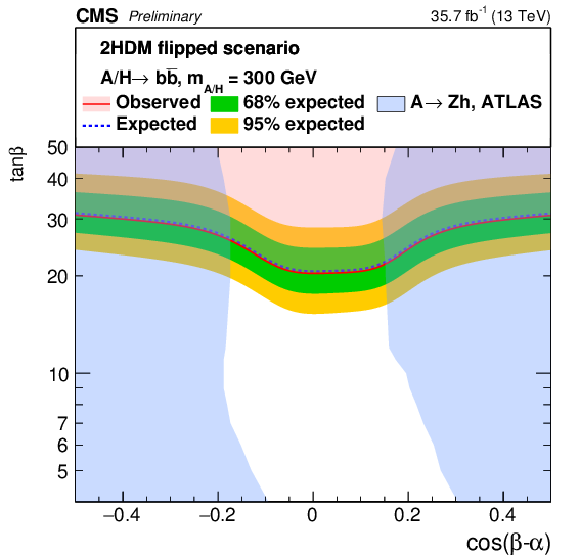
png pdf |
Figure 9-a:
Upper limits for the parameter $ \tan \beta $ at 95% confidence level for the flipped (upper) and type-II (lower) models, as a function of $\cos (\beta -\alpha)$ in the range of $[-0.5,0.5]$ for the mass $m_{\rm H}=m_{\rm A}= $ 300 GeV. The results from the ATLAS $\mathrm {A} \rightarrow {\mathrm {Z}} {\mathrm {h}} $ analysis [32] are also shown as blue shaded area for comparison which provide limits up to $ \tan \beta $ of 50. |
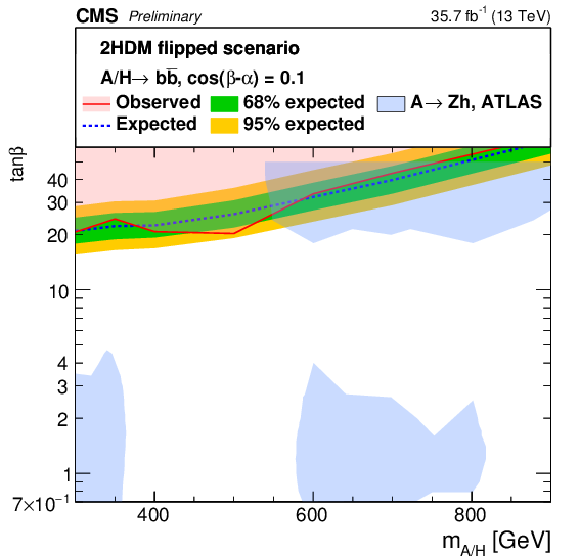
png pdf |
Figure 9-b:
Upper limits for the parameter $ \tan \beta $ at 95% confidence level for the flipped (upper) and type-II (lower) models, as a function of ${m_{\mathrm {A/H}}}$ when $\cos (\beta -\alpha) = $ 0.1. The results from the ATLAS $\mathrm {A} \rightarrow {\mathrm {Z}} {\mathrm {h}} $ analysis [32] are also shown as blue shaded area for comparison which provide limits up to $ \tan \beta $ of 50. |

png pdf |
Figure 9-c:
Upper limits for the parameter $ \tan \beta $ at 95% confidence level for the flipped (upper) and type-II (lower) models, as a function of $\cos (\beta -\alpha)$ in the range of $[-0.5,0.5]$ for the mass $m_{\rm H}=m_{\rm A}= $ 300 GeV (left) and as a function of ${m_{\mathrm {A/H}}}$ when $\cos (\beta -\alpha) = $ 0.1 (right). The results from the ATLAS $\mathrm {A} \rightarrow {\mathrm {Z}} {\mathrm {h}} $ analysis [32] are also shown as blue shaded area for comparison which provide limits up to $ \tan \beta $ of 50. |
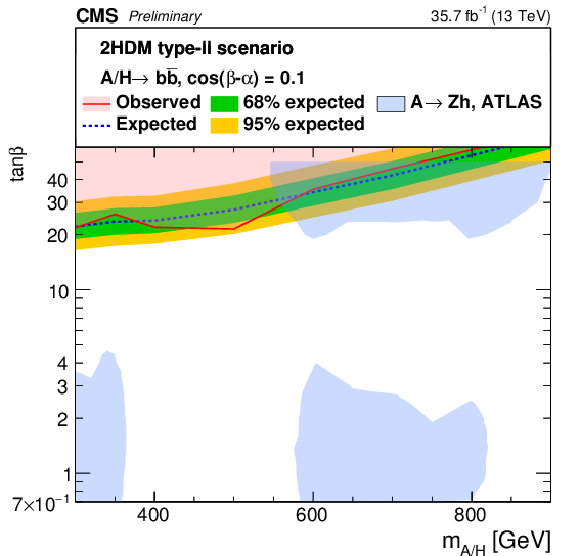
png pdf |
Figure 9-d:
Upper limits for the parameter $ \tan \beta $ at 95% confidence level for the flipped (upper) and type-II (lower) models, as a function of $\cos (\beta -\alpha)$ in the range of $[-0.5,0.5]$ for the mass $m_{\rm H}=m_{\rm A}= $ 300 GeV (left) and as a function of ${m_{\mathrm {A/H}}}$ when $\cos (\beta -\alpha) = $ 0.1 (right). The results from the ATLAS $\mathrm {A} \rightarrow {\mathrm {Z}} {\mathrm {h}} $ analysis [32] are also shown as blue shaded area for comparison which provide limits up to $ \tan \beta $ of 50. |
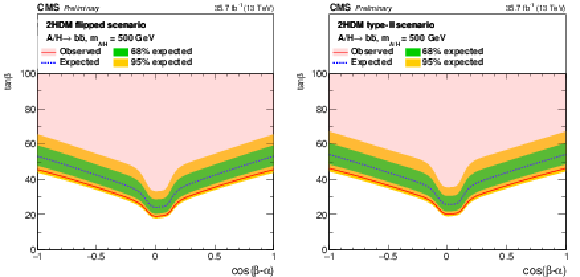
png pdf |
Figure 10:
Upper limits for the parameter $ \tan \beta $ at 95% confidence level for the flipped (left) and type-II (right) models as a function of $\cos (\beta -\alpha)$ in the full range of $[-1.0,1.0]$, for the mass $m_{\rm H}=m_{\rm A}= $ 500 GeV. The inner (green) band and the outer (yellow) band indicate the regions containing 68 and 95%, respectively, of the distribution of limits expected under the background-only hypothesis. |
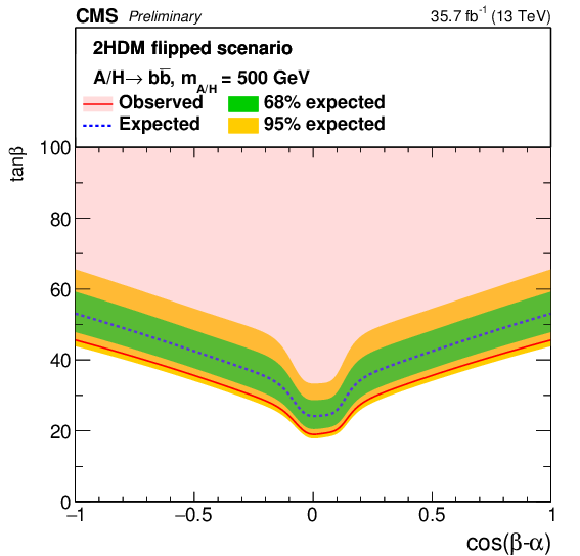
png pdf |
Figure 10-a:
Upper limits for the parameter $ \tan \beta $ at 95% confidence level for the flipped model as a function of $\cos (\beta -\alpha)$ in the full range of $[-1.0,1.0]$, for the mass $m_{\rm H}=m_{\rm A}= $ 500 GeV. The inner (green) band and the outer (yellow) band indicate the regions containing 68 and 95%, respectively, of the distribution of limits expected under the background-only hypothesis. |
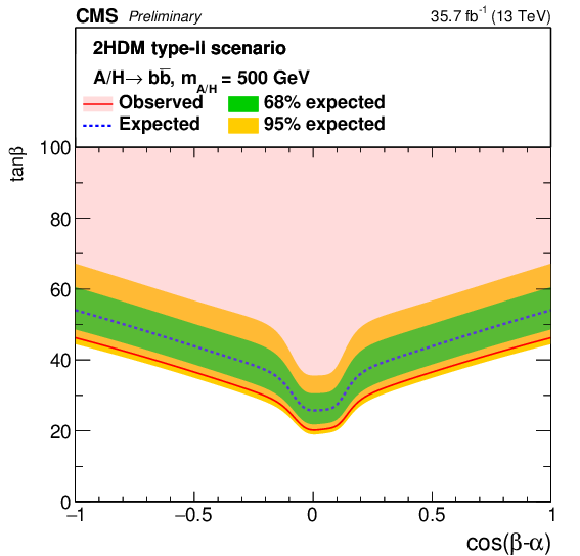
png pdf |
Figure 10-b:
Upper limits for the parameter $ \tan \beta $ at 95% confidence level for the type-II model as a function of $\cos (\beta -\alpha)$ in the full range of $[-1.0,1.0]$, for the mass $m_{\rm H}=m_{\rm A}= $ 500 GeV. The inner (green) band and the outer (yellow) band indicate the regions containing 68 and 95%, respectively, of the distribution of limits expected under the background-only hypothesis. |
| Tables | |
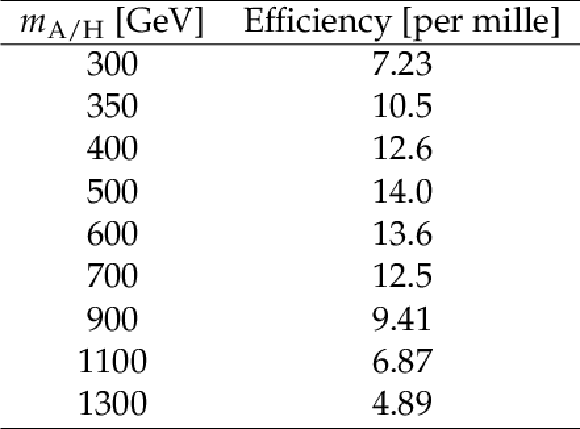
png pdf |
Table 1:
The total signal efficiency in per mille as a function of the Higgs boson mass ${m_{\mathrm {A/H}}}$. |
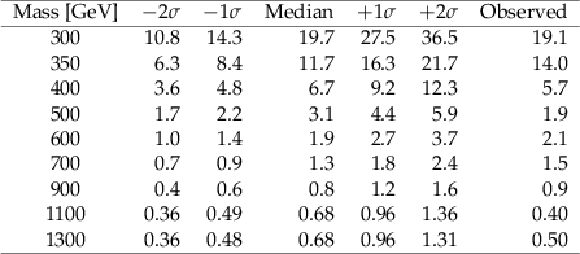
png pdf |
Table 2:
Expected and observed CLs upper limits on $\sigma ({\mathrm {p}} {\mathrm {p}}\to {\mathrm {b}} {\rm A/H}+\mathrm {X})\, \mathcal {B}({\rm A/H}\to {{\mathrm {b}} {\overline {\mathrm {b}}}})$ in pb as a function of ${m_{\mathrm {A/H}}}$, as obtained from the 13 TeV data. |
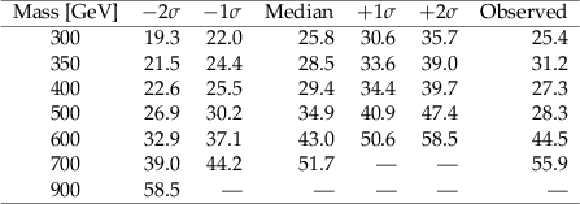
png pdf |
Table 3:
Expected and observed CLs upper limits on $ \tan \beta $ as a function of ${m_{\mathrm {A}}} in the {m_{{\mathrm {h}}}^{\text {mod+}}}$, $\mu = $ +200 GeV, benchmark scenario obtained from a 13 TeV data. Since theoretical predictions for $ \tan \beta > $ 60 are not reliable, cells for which $ \tan \beta $ would exceed this value are indicated by --. |
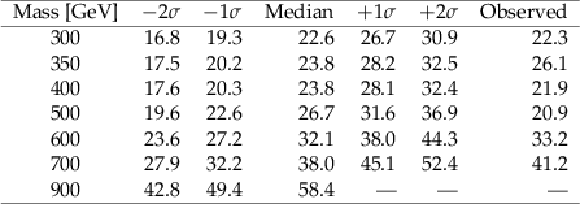
png pdf |
Table 4:
Expected and observed CLs upper limits on $ \tan \beta $ as a function of ${m_{\mathrm {A}}}$ in the hMSSM, $\mu = $ +200 GeV, benchmark scenario obtained from a 13 TeV data. Since theoretical predictions for $ \tan \beta > $ 60 are not reliable, cells for which $ \tan \beta $ would exceed this value are indicated by --. |

png pdf |
Table 5:
Expected and observed CLs upper limits on $ \tan \beta $ as a function of ${m_{\mathrm {A}}}$ in the light $ \tilde{\tau} $, $\mu = $ +200 GeV, benchmark scenario. Since theoretical predictions for $ \tan \beta > 60$ are not reliable, cells for which $ \tan \beta $ would exceed this value are indicated by --. |

png pdf |
Table 6:
Expected and observed CLs upper limits on $ \tan \beta $ as a function of ${m_{\mathrm {A}}}$ in the light $ \tilde{\mathrm{t}} $, $\mu = $ +200 GeV, benchmark scenario. Since theoretical predictions for $ \tan \beta > $ 60 are not reliable, cells for which $ \tan \beta $ would exceed this value are indicated by --. |
| Summary |
|
A search for a heavy Higgs boson decaying into a b quark-antiquark pair and accompanied by at least one additional b quark has been performed. The data analyzed correspond to an integrated luminosity of 35.7 fb$^{-1}$, recorded in pp collisions at a centre-of-mass energy of 13 TeV at the LHC. For this purpose, dedicated triggers using all-hadronic jet signatures combined with online b tagging were developed. The signal is characterized by events with at least three b-tagged jets. The search has been performed in the invariant mass spectrum of the two leading b-tagged jets. No evidence for a signal is found. Upper limits on the Higgs boson cross section times branching fraction are obtained in the mass region 300-1300 GeV at 95% confidence level. They range from about 20 pb at the lower end of the mass range, to about 0.4 pb at 1100 GeV, and extend to considerably higher masses than those accessible to previous analyses performed. The results are interpreted within various MSSM benchmark scenarios. They yield upper limits on the model parameter ${\tan\beta}$ as a function of the mass parameter ${m_{\mathrm{A}}} $. The observed limit for ${\tan\beta}$ ranges down to about 25 at the lowest ${m_{\mathrm{A}}}$ value of 300 GeV in the ${m_{\mathrm{h}}^{\text{mod+}}} $ scenario with a higgsino mass parameter of $\mu= $ +200 GeV. The results are also interpreted in the 2HDM type-II and flipped scenarios. The limits obtained for the flipped scenario provide the only experimental upper limits in the region around zero of $\cos(\beta-\alpha)$, and strong unique constraints on $\tan\beta$. |
| References | ||||
| 1 | H. P. Nilles | Supersymmetry, supergravity and particle physics | PR 110 (1984) 1 | |
| 2 | G. C. Branco et al. | Theory and phenomenology of two-Higgs-doublet models | Phys. Rep. 516 (2012) 1 | 1106.0034 |
| 3 | ATLAS Collaboration | Observation of a new particle in the search for the Standard Model Higgs boson with the ATLAS detector at the LHC | PLB 716 (2012) 1 | 1207.7214 |
| 4 | CMS Collaboration | Observation of a new boson at a mass of 125 GeV with the CMS experiment at the LHC | PLB 716 (2012) 30 | CMS-HIG-12-028 1207.7235 |
| 5 | CMS Collaboration | Observation of a new boson with mass near 125 GeV in pp collisions at $ \sqrt{s} = $ 7 and 8 TeV | JHEP 06 (2013) 081 | CMS-HIG-12-036 1303.4571 |
| 6 | M. Carena et al. | MSSM Higgs boson searches at the LHC: benchmark scenarios after the discovery of a Higgs-like particle | EPJC 73 (2013) 2552 | 1302.7033 |
| 7 | M. S. Carena, S. Heinemeyer, C. E. M. Wagner, and G. Weiglein | MSSM Higgs boson searches at the Tevatron and the LHC: Impact of different benchmark scenarios | EPJC 45 (2006) 797 | hep-ph/0511023 |
| 8 | ALEPH, DELPHI, L3, and OPAL Collaborations, LEP Working Group for Higgs Boson Searches | Search for neutral MSSM Higgs bosons at LEP | EPJC 47 (2006) 547 | hep-ex/0602042 |
| 9 | M. Carena, S. Heinemeyer, C. E. M. Wagner, and G. Weiglein | Suggestions for benchmark scenarios for MSSM Higgs boson searches at hadron colliders | EPJC 26 (2003) 601 | hep-ph/0202167 |
| 10 | S. Heinemeyer, W. Hollik, and G. Weiglein | Constraints on $ {\tan\beta} $ in the MSSM from the upper bound on the mass of the lightest Higgs boson | JHEP 06 (2000) 009 | hep-ph/9909540 |
| 11 | L. Maiani, A. D. Polosa, and V. Riquer | Bounds to the Higgs Sector Masses in Minimal Supersymmetry from LHC Data | PLB 724 (2013) 274 | 1305.2172 |
| 12 | A. Djouadi et al. | The post-Higgs MSSM scenario: Habemus MSSM? | EPJC 73 (2013) 2650 | 1307.5205 |
| 13 | A. Djouadi et al. | Fully covering the MSSM Higgs sector at the LHC | JHEP 06 (2015) 168 | 1502.05653 |
| 14 | LHC Higgs Cross Section Working Group | Benchmark scenarios for low $ \tan \beta $ in the MSSM | Public Note LHCHXSWG-2015-002, CERN, Geneva | |
| 15 | LHC Higgs Cross Section Working Group | Handbook of LHC Higgs Cross Sections: 3. Higgs Properties | 1307.1347 | |
| 16 | E. Izaguirre, G. Krnjaic, and B. Shuve | Bottom-up approach to the Galactic Center excess | PRD 90 (2014) 055002 | 1404.2018 |
| 17 | A. Berlin, D. Hooper, and S. D. McDermott | Simplified dark matter models for the Galactic Center gamma-ray excess | PRD 89 (2014) 115022 | 1404.0022 |
| 18 | CMS Collaboration | Search for neutral Higgs bosons decaying to tau pairs in pp collisions at $ \sqrt{s}= $ 7 ~TeV | PLB 713 (2012) 68 | CMS-HIG-11-029 1202.4083 |
| 19 | ATLAS Collaboration | Search for the neutral Higgs bosons of the minimal supersymmetric standard model in pp collisions at $ \sqrt{s}= $ 7 TeV with the ATLAS detector | JHEP 02 (2013) 095 | 1211.6956 |
| 20 | CMS Collaboration | Search for neutral MSSM Higgs bosons decaying to a pair of tau leptons in pp collisions | JHEP 10 (2014) 160 | CMS-HIG-13-021 1408.3316 |
| 21 | ATLAS Collaboration | Search for neutral Higgs bosons of the minimal supersymmetric standard model in pp collisions at $ \sqrt{s} = $ 8 TeV with the ATLAS detector | JHEP 11 (2014) 056 | 1409.6064 |
| 22 | CMS Collaboration | Search for a neutral MSSM Higgs boson decaying into $ \tau\tau $ with $ 12.9 \mathrm{fb}^{-1} $ of data at $ \sqrt{s}= $ 13 TeV | CMS-PAS-HIG-16-037 | CMS-PAS-HIG-16-037 |
| 23 | ATLAS Collaboration | Search for additional heavy neutral Higgs and gauge bosons in the ditau final state produced in 36 fb$ ^{-1} $ of pp collisions at $ \sqrt{s}= $ 13 TeV with the ATLAS detector | JHEP 01 (2018) 055 | 1709.07242 |
| 24 | CDF Collaboration | Search for Higgs Bosons Predicted in Two-Higgs-Doublet Models via Decays to Tau Lepton Pairs in 1.96~TeV p$ \overline{\mathrm{p}} $ Collisions | PRL 103 (2009) 201801 | 0906.1014 |
| 25 | D0 Collaboration | Search for Higgs Bosons Decaying to Tau Pairs in p$ \overline{\mathrm{p}} $ Collisions with the D0 Detector | PRL 101 (2008) 071804 | 0805.2491 |
| 26 | D0 Collaboration | Search for Higgs bosons of the minimal supersymmetric standard model p$ \overline{\mathrm{p}} $ in collisions at $ {\sqrt{s}=1.96 TeV} $ | PLB 710 (2012) 569 | 1112.5431 |
| 27 | CMS Collaboration | Search for neutral MSSM Higgs bosons decaying to $ \mu^{+} \mu^{-} $ in pp collisions at $ \sqrt{s} = $ 7 and 8 TeV | PLB 752 (2016) 221 | CMS-HIG-13-024 1508.01437 |
| 28 | CDF and D0 Collaborations | Search for neutral Higgs bosons in events with multiple bottom quarks at the Tevatron | PRD 86 (2012) 091101 | 1207.2757 |
| 29 | CMS Collaboration | Search for a Higgs boson decaying into a b-quark pair and produced in association with b quarks in proton-proton collisions at 7 TeV | PLB 722 (2013) 207 | CMS-HIG-12-033 1302.2892 |
| 30 | CMS Collaboration | Search for neutral MSSM Higgs bosons decaying into a pair of bottom quarks | JHEP 11 (2015) 071 | CMS-HIG-14-017 1506.08329 |
| 31 | ATLAS Collaboration | Search for a CP-odd Higgs boson decaying to Zh in pp collisions at $ \sqrt{s} = $ 8 TeV with the ATLAS detector | PLB 744 (2015) 163 | 1502.04478 |
| 32 | ATLAS Collaboration | Search for heavy resonances decaying into a $ W $ or $ Z $ boson and a Higgs boson in final states with leptons and b-jets in 36Zfb$ ^{-1} $ of $ \sqrt{s} = $ 13 ~$ TeV\ $ pp collisions with the ATLAS detector | Submitted to \it JHEP | 1712.06518 |
| 33 | CMS Collaboration | The CMS experiment at the CERN LHC | JINST 3 (2008) S08004 | CMS-00-001 |
| 34 | CMS Collaboration | Particle-flow reconstruction and global event description with the CMS detector | JINST 12 (2017) P10003 | CMS-PRF-14-001 1706.04965 |
| 35 | CMS Collaboration | Description and performance of track and primary-vertex reconstruction with the CMS tracker | JINST 9 (2014) P10009 | CMS-TRK-11-001 1405.6569 |
| 36 | M. Cacciari, G. P. Salam, and G. Soyez | The anti-$ k_t $ jet clustering algorithm | JHEP 04 (2008) 063 | 0802.1189 |
| 37 | M. Cacciari, G. P. Salam, and G. Soyez | FastJet User Manual | EPJC 72 (2012) | 1111.6097 |
| 38 | CMS Collaboration | Pileup removal algorithms | CMS-PAS-JME-14-001 | CMS-PAS-JME-14-001 |
| 39 | M. Cacciari and G. P. Salam | Pileup subtraction using jet areas | PLB 659 (2008) 119 | 0707.1378 |
| 40 | CMS Collaboration | Jet energy scale and resolution in the CMS experiment in pp collisions at 8 TeV | JINST 12 (2017) P02014 | CMS-JME-13-004 1607.03663 |
| 41 | CMS Collaboration | Identification of heavy-flavour jets with the CMS detector in pp collisions at 13 TeV | Submitted to \it JINST | CMS-BTV-16-002 1712.07158 |
| 42 | T. Sjostrand, S. Mrenna, and P. Skands | A brief introduction to PYTHIA 8.1 | Comp. Phys. Comm. 178 (2008) 852 | 0710.3820 |
| 43 | LHC Higgs Cross Section Working Group, S. Dittmaier et al. | Handbook of LHC Higgs Cross Sections: 2. Differential Distributions | 1201.3084 | |
| 44 | J. Alwall et al. | The automated computation of tree-level and next-to-leading order differential cross sections, and their matching to parton shower simulations | JHEP 07 (2014) 079 | 1405.0301 |
| 45 | M. Wiesemann et al. | Higgs production in association with bottom quarks | JHEP 02 (2015) 132 | 1409.5301 |
| 46 | R. Frederix, S. Frixione, F. Maltoni, and T. Stelzer | Automation of next-to-leading order computations in QCD: The FKS subtraction | JHEP 10 (2009) 003 | 0908.4272 |
| 47 | V. Hirschi et al. | Automation of one-loop QCD corrections | JHEP 05 (2011) 044 | 1103.0621 |
| 48 | R. D. Ball et al. | Impact of Heavy Quark Masses on Parton Distributions and LHC Phenomenology | NPB 849 (2011) 296 | 1101.1300 |
| 49 | CMS Collaboration | Event generator tunes obtained from underlying event and multiparton scattering measurements | EPJC 76 (2016) 155 | CMS-GEN-14-001 1512.00815 |
| 50 | GEANT4 Collaboration | GEANT4: a simulation toolkit | NIMA 506 (2003) 250 | |
| 51 | CMS Collaboration | The CMS trigger system | JINST 12 (2017) P01020 | CMS-TRG-12-001 1609.02366 |
| 52 | Belle Collaboration | A detailed test of the CsI(Tl) calorimeter for BELLE with photon beams of energy between 20-MeV and 5.4-GeV | NIMA 441 (2000) 401 | |
| 53 | CMS Collaboration | Search for massive resonances decaying into WW, WZ or ZZ bosons in proton-proton collisions at $ \sqrt{s} = $ 13 TeV | JHEP 03 (2017) 162 | CMS-B2G-16-004 1612.09159 |
| 54 | CMS Collaboration | CMS Luminosity Measurements for the 2016 Data Taking Period | CMS-PAS-LUM-17-001 | CMS-PAS-LUM-17-001 |
| 55 | LHC Higgs Cross Section Working Group, D. de Florian et al. | Handbook of LHC Higgs Cross Sections: 4. Deciphering the Nature of the Higgs Sector | 1610.07922 | |
| 56 | T. Junk | Confidence level computation for combining searches with small statistics | NIMA 434 (1999) 435 | hep-ex/9902006 |
| 57 | A. L. Read | Presentation of search results: The $ CL_s $ technique | JPG 28 (2002) 2693 | |
| 58 | L. Moneta et al. | The RooStats Project | in 13th International Workshop on Advanced Computing and Analysis Techniques in Physics Research (ACAT2010) SISSA | 1009.1003 |
| 59 | S. Dittmaier, M. Kramer, and M. Spira | Higgs radiation off bottom quarks at the Tevatron and the CERN LHC | PRD 70 (2004) 074010 | hep-ph/0309204 |
| 60 | S. Dawson, C. B. Jackson, L. Reina, and D. Wackeroth | Exclusive Higgs boson production with bottom quarks at hadron colliders | PRD 69 (2004) 074027 | hep-ph/0311067 |
| 61 | R. V. Harlander and W. B. Kilgore | Higgs boson production in bottom quark fusion at next-to-next-to leading order | PRD 68 (2003) 013001 | hep-ph/0304035 |
| 62 | R. V. Harlander, M. Kramer, and M. Schumacher | Bottom-quark associated Higgs-boson production: reconciling the four- and five-flavour scheme approach | CERN Preprint | 1112.3478 |
| 63 | G. Degrassi et al. | Towards high-precision predictions for the MSSM Higgs sector | EPJC 28 (2003) 133 | hep-ph/0212020 |
| 64 | M. Frank et al. | The Higgs boson masses and mixings of the complex MSSM in the Feynman-diagrammatic approach | JHEP 02 (2007) 047 | hep-ph/0611326 |
| 65 | S. Heinemeyer, W. Hollik, and G. Weiglein | FeynHiggs: A program for the calculation of the masses of the neutral CP even Higgs bosons in the MSSM | CPC 124 (2000) 76 | hep-ph/9812320 |
| 66 | S. Heinemeyer, W. Hollik, and G. Weiglein | The Masses of the neutral CP - even Higgs bosons in the MSSM: Accurate analysis at the two loop level | EPJC 9 (1999) 343 | hep-ph/9812472 |
| 67 | A. Djouadi, J. Kalinowski, and M. Spira | HDECAY: A Program for Higgs boson decays in the standard model and its supersymmetric extension | CPC 108 (1998) 56 | hep-ph/9704448 |
| 68 | A. Djouadi, M. M. Muhlleitner, and M. Spira | Decays of supersymmetric particles: The Program SUSY-HIT | in Physics at LHC. Proceedings, 3rd Conference, Cracow, Poland, July 3-8, 2006, volume 38, p. 635 2007 | hep-ph/0609292 |
| 69 | R. V. Harlander, S. Liebler, and H. Mantler | SusHi: A program for the calculation of Higgs production in gluon fusion and bottom-quark annihilation in the Standard Model and the MSSM | CPC 184 (2013) 1605 | 1212.3249 |
| 70 | D. Eriksson, J. Rathsman, and O. St\aal | 2HDMC: Two-Higgs-Doublet Model Calculator Physics and Manual | CPC 181 (2010) 189 | 0902.0851 |
| 71 | A. Buckley et al. | LHAPDF6: parton density access in the LHC precision era | EPJC 75 (2015) 132 | 1412.7420 |
| 72 | H. E. Haber and O. St\aal | New LHC benchmarks for the $ \mathcal{CP} $ -conserving two-Higgs-doublet model | EPJC 75 (2015) 491 | 1507.04281 |

|
Compact Muon Solenoid LHC, CERN |

|

|

|

|

|

|